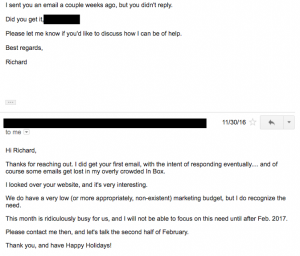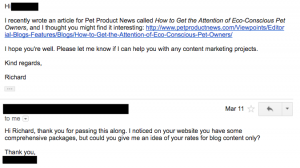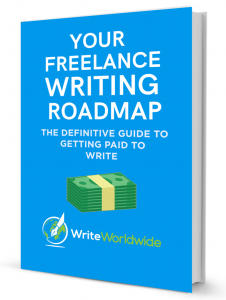No matter where you are in your freelance writing career, there’s a proven strategy you can use to land more work.
You’ve probably heard about it, maybe you do it yourself, but the fact is that most freelance writers don’t do it nearly enough.
Practice it consistently and you’re sure to land more work. It’s not difficult to do, and it won’t take you long. But it will take planning and persistence.
The proven strategy to land more freelance writing work I’ll be discussing today is: systematically following-up with prospects and clients. Read on to find out more…
Following-Up With Prospects
Prospects are the people you’ve identified as being a good fit for your services. It’s beyond the scope of this post to go into detail about the process of identifying prospects, but in a nutshell, you should track down decision makers in businesses that have a need for the services you provide.
The LinkedIn people search tool is ideal for this task. For more information check out my post How to Find Freelance Writing Clients on LinkedIn (A System That Works).
Make sure you have a good-sized list of prospects to market to. A list of at least 100 prospects is enough to get started.
Once you have your list, you’re ready to start your marketing campaign. LinkedIn marketing is my preferred method, but there are lots of alternative marketing methods to choose from such as cold emailing, direct mail or cold calling.
Choose the one you like best, and stick with it long enough to get results.
Start your marketing campaign by crafting a solid pitch and sending it to everyone on your list. If you decide to go with LinkedIn marketing, be sure to delve into my recent post, A Deep Dive Breakdown of My Winning LinkedIn Pitch.
When you’ve sent your pitches, don’t make the mistake of thinking your work is done. To give yourself the best chance of success, you need to put an effective follow-up strategy into play.
The 3-7-7 Formula
The WriteWorldwide team are big proponents of Bamidele Onibalusi’s 3-7-7 formula. It’s designed to significantly boost responses to your pitches using a simple system anyone can implement.
The ‘3’ in the formula means you should send your first follow-up 3 days after sending your initial pitch. The first ‘7’ represents the timing of your second follow-up – 7 days after the last, and the next ‘7’ means you should send your final follow-up 7 days later.
Of course, once you receive a reply to any of your messages you can stop following-up and start a conversation with the prospect!
This approach works because people are busy. Too many freelance writers make the mistake of believing that if they don’t get an answer to their first pitch the prospect isn’t interested. Never assume this is the case.
Lots of business people mean to reply to your email but get side-tracked and forget. Try this follow-up formula for yourself and see the results it brings.
Keeping Track of Your Follow-Ups
Make sure to keep track of your follow ups with a spreadsheet or calendar app. If you prefer, a paper planner works just as well.
Simply record the details of the first contact and the dates you’ll need to follow-up according to the 3-7-7 formula. This will make it much easier to keep track of when to follow-up with prospects, so you don’t miss out on any opportunities.
Basic Follow-Up Templates
Below are the basic follow-up templates I’ve successfully used for my marketing campaigns. The templates each have a purpose and psychology behind them – to follow-up in a non-threatening way, and gently encourage the prospect to respond to my messages.
If you choose cold emailing as your marketing strategy, I highly recommend using Bamidele’s pitch templates to craft your first message to prospects. Check out this page from his Earn Your First $1000 as a Freelance Writer challenge where you’ll find two templates that get the job done.
With Bamidele’s templates you can be confident you’ve sent a solid first pitch. This is especially important for beginners, because if your first pitch is bad you won’t get a second chance.
Resist the temptation to alter the structure of the pitches. They are carefully constructed and proven to work.
I’ve personally used Bamidele’s cold pitch templates (example 1 is my favourite) to land several clients. The pitches are effective, so please make use of these fantastic resources!
So, after you’ve sent your initial pitch how do you follow-up? Here’s a simple template I’ve used to send the first follow-up in the 3-7-7 formula:
The Standard Follow-Up Template
I sent you an email last week, but you didn’t reply.
Did you get it <first name>?
Please let me know if you’d like to discuss how I can be of help.
Best regards,
Richard
Here’s a screenshot of the template in action:

*Note* this company is now one of my best clients. Despite their budget concerns, we were able to negotiate a retainer deal for an e-newsletter and 2 blog posts per month. As always, centre the conversation around the benefits you can offer the client.
The Reconnect
Sometimes you’ll find you’ve identified a good prospect, but for whatever reason, they just aren’t ready to do business with you right now. Alternatively, you may have a lucrative client you’ve been working with, but lately the work has dried up.
This is where most freelance writers give up. Don’t make that mistake. Continue to keep these types of prospects and clients on your radar. As you’ll see, things can work out in the end … Here’s a great way to reconnect with a dormant prospect:
Hi <first name>,
I recently wrote an article for <publication name> called <article title>, and I thought you might find it interesting: <link>
I hope you’re well. Please let me know if I can help you with any content marketing projects.
Kind regards,
Richard
Here’s a screenshot of this template working its magic:

*Note* After some back-and-forth this client also agreed to a monthly retainer.
Why does this work so well? Simply because you’re putting yourself back in front of the prospect or client in a valuable and non-threatening way.
Instead of constantly asking for work, you’re demonstrating your expertise and opening the door to a new conversation. If you’ve written an article your unresponsive client or prospect may be interested in, give this one a go.
Further Follow-Ups
These 2 follow-up templates will set you on the path to landing plenty of new work. But you may be wondering how to complete the 3-7-7 formula.
As a quick reminder, the formula says you should follow-up 3 times; 3 days after the initial pitch, 7 days after that, and a final follow-up 7 days after the last.
If you receive no response to your messages, don’t be afraid to follow the 3-7-7 formula to it’s logical conclusion. Business people really are busy, and you’ll miss lots of opportunities if you fail to follow-up.
There’s no one way to keep following up. Use your imagination, but keep your messages brief, casual and to the point.
If you’d like more information, post your follow-up below and I’ll be happy to give you some pointers!




Hi. Thanks for this useful post! I am following up with prospects almost daily. More than 3 times for one prospect. What do you think about those who don’t reply even the 3rd, 4th and 5th time you reach out?
Hi Marlena,
Glad you found this post useful.
It seems like you have a good routine for following up – keep at it and I’m sure you’ll get some great results (if you haven’t already)!
Personally, I like to follow up around 4 times. I’ve noticed that very few people will reply after that, so I prefer to spend my time looking for new prospects. Some people like to follow up more (or less) than I do. I’d encourage you to look at your own numbers to decide what works best for you.
Good luck!
Richard